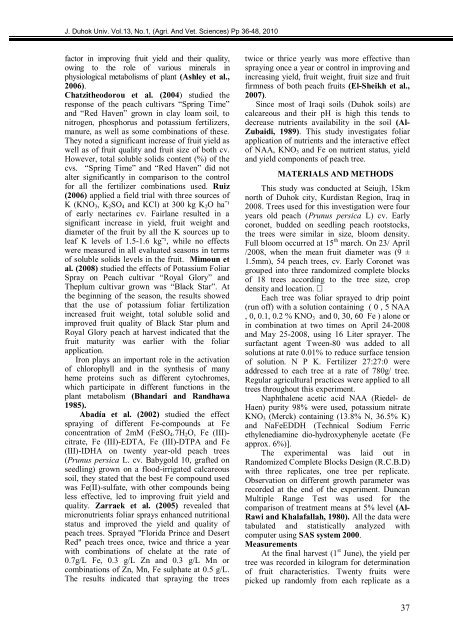The Influence Of Priming Two Cucumber Cultivar Seeds
The Influence Of Priming Two Cucumber Cultivar Seeds
The Influence Of Priming Two Cucumber Cultivar Seeds
Create successful ePaper yourself
Turn your PDF publications into a flip-book with our unique Google optimized e-Paper software.
J. Duhok Univ. Vol.13, No.1, (Agri. And Vet. Sciences) Pp 36-48, 2010<br />
factor in improving fruit yield and their quality,<br />
owing to the role of various minerals in<br />
physiological metabolisms of plant (Ashley et al.,<br />
2006).<br />
Chatzitheodorou et al. (2004) studied the<br />
response of the peach cultivars “Spring Time”<br />
and “Red Haven” grown in clay loam soil, to<br />
nitrogen, phosphorus and potassium fertilizers,<br />
manure, as well as some combinations of these.<br />
<strong>The</strong>y noted a significant increase of fruit yield as<br />
well as of fruit quality and fruit size of both cv.<br />
However, total soluble solids content (%) of the<br />
cvs. “Spring Time” and “Red Haven” did not<br />
alter significantly in comparison to the control<br />
for all the fertilizer combinations used. Ruiz<br />
(2006) applied a field trial with three sources of<br />
K (KNO3, K2SO4 and KCl) at 300 kg K2O haˉ¹<br />
of early nectarines cv. Fairlane resulted in a<br />
significant increase in yield, fruit weight and<br />
diameter of the fruit by all the K sources up to<br />
leaf K levels of 1.5-1.6 kgˉ¹, while no effects<br />
were measured in all evaluated seasons in terms<br />
of soluble solids levels in the fruit. Mimoun et<br />
al. (2008) studied the effects of Potassium Foliar<br />
Spray on Peach cultivar “Royal Glory” and<br />
<strong>The</strong>plum cultivar grown was “Black Star”. At<br />
the beginning of the season, the results showed<br />
that the use of potassium foliar fertilization<br />
increased fruit weight, total soluble solid and<br />
improved fruit quality of Black Star plum and<br />
Royal Glory peach at harvest indicated that the<br />
fruit maturity was earlier with the foliar<br />
application.<br />
Iron plays an important role in the activation<br />
of chlorophyll and in the synthesis of many<br />
heme proteins such as different cytochromes,<br />
which participate in different functions in the<br />
plant metabolism (Bhandari and Randhawa<br />
1985).<br />
Abadía et al. (2002) studied the effect<br />
spraying of different Fe-compounds at Fe<br />
concentration of 2mM (FeSO4.7H2O, Fe (III)citrate,<br />
Fe (III)-EDTA, Fe (III)-DTPA and Fe<br />
(III)-IDHA on twenty year-old peach trees<br />
(Prunus persica L. cv. Babygold 10, grafted on<br />
seedling) grown on a flood-irrigated calcareous<br />
soil, they stated that the best Fe compound used<br />
was Fe(II)-sulfate, with other compounds being<br />
less effective, led to improving fruit yield and<br />
quality. Zarraek et al. (2005) revealed that<br />
micronutrients foliar sprays enhanced nutritional<br />
status and improved the yield and quality of<br />
peach trees. Sprayed "Florida Prince and Desert<br />
Red" peach trees once, twice and thrice a year<br />
with combinations of chelate at the rate of<br />
0.7g/L Fe, 0.3 g/L Zn and 0.3 g/L Mn or<br />
combinations of Zn, Mn, Fe sulphate at 0.5 g/L.<br />
<strong>The</strong> results indicated that spraying the trees<br />
twice or thrice yearly was more effective than<br />
spraying once a year or control in improving and<br />
increasing yield, fruit weight, fruit size and fruit<br />
firmness of both peach fruits (El-Sheikh et al.,<br />
2007).<br />
Since most of Iraqi soils (Duhok soils) are<br />
calcareous and their pH is high this tends to<br />
decrease nutrients availability in the soil (Al-<br />
Zubaidi, 1989). This study investigates foliar<br />
application of nutrients and the interactive effect<br />
of NAA, KNO3 and Fe on nutrient status, yield<br />
and yield components of peach tree.<br />
MATERIALS AND METHODS<br />
This study was conducted at Seiujh, 15km<br />
north of Duhok city, Kurdistan Region, Iraq in<br />
2008. Trees used for this investigation were four<br />
years old peach (Prunus persica L) cv. Early<br />
coronet, budded on seedling peach rootstocks,<br />
the trees were similar in size, bloom density.<br />
Full bloom occurred at 15 th march. On 23/ April<br />
/2008, when the mean fruit diameter was (9 ±<br />
1.5mm), 54 peach trees, cv. Early Coronet was<br />
grouped into three randomized complete blocks<br />
of 18 trees according to the tree size, crop<br />
density and location.<br />
Each tree was foliar sprayed to drip point<br />
(run off) with a solution containing ( 0 , 5 NAA<br />
, 0, 0.1, 0.2 % KNO3 and 0, 30, 60 Fe ) alone or<br />
in combination at two times on April 24-2008<br />
and May 25-2008, using 16 Liter sprayer. <strong>The</strong><br />
surfactant agent Tween-80 was added to all<br />
solutions at rate 0.01% to reduce surface tension<br />
of solution. N P K. Fertilizer 27:27:0 were<br />
addressed to each tree at a rate of 780g/ tree.<br />
Regular agricultural practices were applied to all<br />
trees throughout this experiment.<br />
Naphthalene acetic acid NAA (Riedel- de<br />
Haen) purity 98% were used, potassium nitrate<br />
KNO3 (Merck) containing (13.8% N, 36.5% K)<br />
and NaFeEDDH (Technical Sodium Ferric<br />
ethylenediamine dio-hydroxyphenyle acetate (Fe<br />
approx. 6%)].<br />
<strong>The</strong> experimental was laid out in<br />
Randomized Complete Blocks Design (R.C.B.D)<br />
with three replicates, one tree per replicate.<br />
Observation on different growth parameter was<br />
recorded at the end of the experiment. Duncan<br />
Multiple Range Test was used for the<br />
comparison of treatment means at 5% level (Al-<br />
Rawi and Khalafallah, 1980). All the data were<br />
tabulated and statistically analyzed with<br />
computer using SAS system 2000.<br />
Measurements<br />
At the final harvest (1 st June), the yield per<br />
tree was recorded in kilogram for determination<br />
of fruit characteristics. Twenty fruits were<br />
picked up randomly from each replicate as a<br />
63



